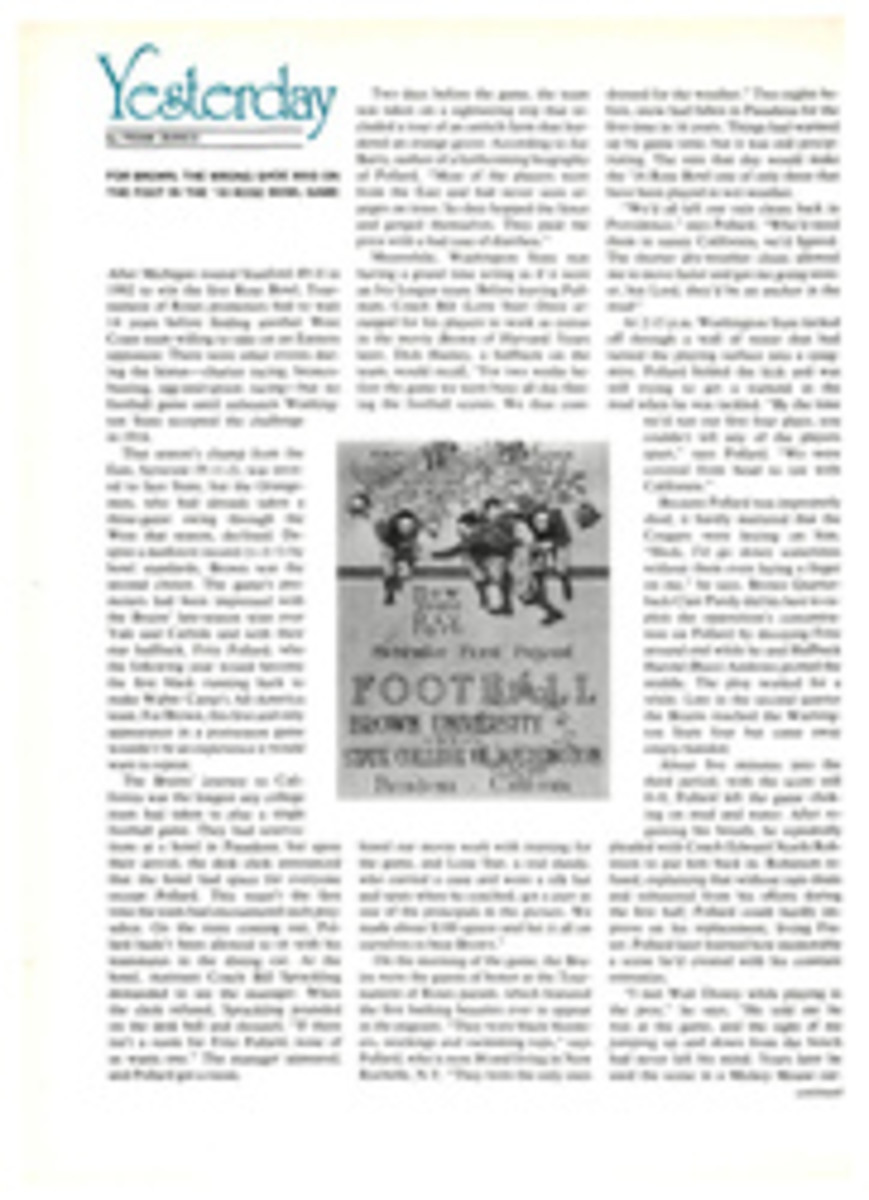
THE RAILCYCLE IS ONE MAN'S METHOD OF MAKING TRACKS IN THE WILDERNESS
The coyote was scurrying along a farm road in the rolling Palouse country of southeastern Washington when Dick Smart, my guide and mentor, spotted him. I might have seen him first, but at the moment of the sighting, I was 60 feet above the road attempting to pedal a Rube Goldberg invention of Smart's—the railcycle—across a trestle that was not equipped with guardrails. I gingerly braked to a stop, just in time to see the coyote disappear, and then, feeling a puff of wind at my back, I lurched forward toward the far side of the trestle. It was my first such crossing—not to mention my first coyote; when I completed it, I felt a certain wobbly pride.
Smart smiled. "Some of my guests aren't ashamed to get off the cycle and walk across," he said as he pedaled his contraption down a less frightening stretch of track.
Smart is a 36-year-old dentist who lives in Coeur d'Alene, Idaho. He's also a regional historian, railroad buff and outdoorsman, and what he has done is pretty much reinvent the wheel. The railcycle, which is his name for a bicycle modified for travel on railroad tracks, brings together the best of two worlds. It offers speed to the ardent backpacker and easy access to the wilderness for the avid cyclist—if they can forget their fear of high places and get the hang of riding Smart's machine.
While much of the estimated 350,000 miles of railroad track in the U.S. offers an unobstructed view of the bowels of Manhattan, the old Chicago stockyards and other such urban delights, some lines pass through areas of unusual beauty. Within a 75-mile radius of Smart's home, for example, are the golden prairies of western Washington, the aforementioned Palouse and the silver-rich Bitter-root mountain range, which rests on the border between Idaho and Montana. All are crisscrossed by a network of railroads, much of it seldom or never used these days, laid nearly a century ago by the three companies—the Great Northern, the Northern Pacific and The Milwaukee Road—that once engaged in furious competition for the lucrative route between Chicago and Seattle, and all are accessible, on a moment's notice, to Smart and his unusual cycle.
There are only two Smart railcycles in existence. He drives the five-speed and his guest uses the three-speed. He has just been granted a patent on his brainchild.
Each railcycle began life as a Schwinn Spitfire, a standard heavy-duty bicycle. Extending downward from the front axle is an assembly consisting of two travel wheels and four guide wheels. The travel wheels, cast-molded urethane jobs cannibalized from a skateboard, ride on top of the rail directly in front of the Spitfire's front wheel, and they are flanked by the guides—rubber wheels six inches in diameter—that extend down the sides of the rail five-eighths of an inch. A similar assembly, made up of one travel wheel and two guide wheels, is directly behind the Spitfire's rear wheel. A railcycle rides the left rail. Extending from the rear axle, roughly parallel to the ground, is an outrigger that stretches to the right rail. At the end of the outrigger is a rubber roller that rides on the far or right rail.
A railcycle has other features rarely seen on a bicycle. A compact but extensive tool kit offers instant aid in case of a mishap. There are head-and taillights, powered by a generator that draws its energy from the rear wheel, and a flashlight up front to give added illumination while transiting train tunnels. A safety brake can be used to prevent a stopped railbike from rolling downhill. For long trips, a small piece of nylon webbing stretched between the outrigger and a support strut allows a rider to bring along a loaded frame pack and other camping essentials. These add-ons (not including the frame pack) bring the total weight of a railcycle to 85 pounds, about 40 pounds more than the original Schwinn.
Riding a railcycle is a tricky proposition. A rail can be from two to 3½ inches wide, and all that keeps a moving railcycle upright on it are those six guide wheels, whose five-eighths-inch overhang is all the fat joiners that hold the rail together every 20 feet or so will permit. Smart warned me that a railcycle was perhaps 25% more difficult to ride than a street bike, and he wasn't kidding.
My maiden voyage, which took place the day before the Great Trestle Crossing, was a 16-mile jaunt through the Bitterroots. We put on northwest of Saltese, Mont, and continued uphill to Lookout Pass, near the Montana-Idaho border, where we turned around.
Boarding a railcycle is a bit like mounting a horse. A section of rail can tower six inches above the ties, and the ties themselves are six inches high. Thus, where there is little or no ballast in the roadbed, you can find yourself sitting about a foot higher in the air than you would if the bike were on solid ground.
Also, the expression "straight as a rail" could never be applied to a railroad. Tracks bow in and out, they lean to the left and right, they go uphill and down, and they negotiate turns. And the turns are banked, like those of a stock car track. These are things you don't notice if you are in the club car sipping a dry martini, but on a railcycle they're quite evident. When the rail leans left, you lean right, and vice versa. In this respect, railcycling is like skateboarding, surfing and sailing: you spend a lot of time heeled over.
There are other hazards. Before Smart added a cowcatcher to his railcycles, small stones could cause derailments. Precipitation, as well as grease and oil, makes the rails slippery. Debris stacked on the tracks by vandals is also of no small concern.
Nonetheless, only one of Smart's guests has suffered a serious injury. About three years ago a rider didn't notice a spike that was wedged in a gap between the ends of two sections of rail and flew head over heels and handlebars, severely gashing his head. Fortunately, Smart got the man to a hospital in plenty of time. A week later the guest was back—wearing a crash helmet.
With this firmly in mind, I negotiated my first quarter-mile with wary ease. Just when I was feeling full of it, however, the front assembly jumped the rail with a clatter. I crashed seven more times in the next VA miles, before settling into a less taxing routine of perhaps one derailment every two miles.
Smart said this was normal for first-time guests. He also pointed out that after a weekend-long ride it usually takes him five or six days to straighten out the guest bike.
With my frequent mishaps slowing us down, we covered about three miles in an hour, roughly twice what a backpacker could expect to make in the mountains. On the upward trek to Lookout Pass, on grades that approached 4% over a vertical distance of 2,000 feet, our speed between derailments hovered around 5 mph; on the return trip, when all we had to do was ride the brakes and enjoy the magnificent scenery, we hit 9 mph. I bravely tried for 10 but promptly derailed again. On a well-packed roadbed over level terrain, Smart can churn along at up to 15 mph. (Where the bed isn't well packed, jumping the rail at that speed can be nasty, sort of like smacking into a 12-inch pothole with a 10-speed bike.) Smart has covered 45 miles in a single day; pressed, he could easily do 75.
But he's in no hurry. He has refused to motorize the railcycle, saying, "It's enough to go slow, enjoy the scenery and have lunch by a mountain stream."
This he does frequently. He takes about 10 all-day or overnight trips a year and often rides for R&R at the end of the work day. His longest jaunt was an 11-day trip to British Columbia last year. He and a guest drove in a pickup to Fort St. James, hopped a train to the Driftwood Logging Camp, near the 55th parallel, and then pedaled 42 miles along an abandoned line into a part of the Canadian wilderness thought in recent years to be accessible only by airplane.
The son of a retired forest supervisor, Smart fell in love with the railroads during a childhood spent in Idaho and western Montana. "One Christmas my biggest present was the one sent to me by an aunt in New England," he says. "I was more fascinated by the fact that the present arrived on The Milwaukee Road than I was by the gift."
One day five years ago he saw a picture of a bicycle-like device with flanged wheels that was kept in the baggage compartments of O.R. & N. trains early in the century. When their trains broke down, brakemen would pedal on the contraption to the next station to find help.
That picture was the catalyst. Smart's first railcycle hit the track in 1976 and jumped it 100 feet later. After much trial and error he came up with his current model. For what purpose, beyond his own enjoyment, he's not sure. He would like to market the railcycle someday, but he fears what would happen if it were used by people not as careful as he. Nor does he know what the official reaction of the railroad companies would be.
Unofficially, it's just fine. Smart pretty much sticks to abandoned lines, though once, on an active line, he had a surprise meeting with a train coming round a mountain bend at perhaps 10 mph. No problem. The railcycle can be removed from the track in a few seconds. His most frequent encounters are with work crews. "Usually," he says, "they want to take a ride."
Sadly, at least for Smart, railroad tracks are often torn up within a year or two of their abandonment. Thus his railcycle is sometimes the last vehicle to ride a disused section of storied track, and that does provide Smart with a certain satisfaction. Says Doug Bruce, a Coeur d'Alene radiologist who is a frequent rider of the guest railcycle, "Given his choice, I think Dick would really prefer to be a hobo."
ILLUSTRATION

